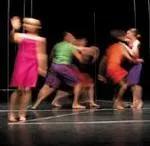Ex-pat choreographer Sue Healey recognised at Reeldance Awards, Sydney
Written by

The choreographer and director of the short dance film Fine Line, Sue Healey, said in her prize-winner's speech on Sunday night that she was starting a new film the next day and until her success was announced, the budget for post-production had been about $75. Now it is $50,000 bigger.
Image: Streamlined for film ... a recent performance of Sue Healey's Fine Line.
The choreographer and director of the short dance film Fine Line, Sue Healey, said in her prize-winner's speech on Sunday night that she was starting a new film the next day and until her success was announced, the budget for post-production had been about $75. Now it is $50,000 bigger.
Image: Streamlined for film ... a recent performance of Sue Healey's Fine Line.
Fine Line, with which she won the Digital Pictures Award for Best Australian and New Zealand Dance Film/Video 2004, had been years and many stages in the making. At nine minutes, with tight framing of the dancers' bodies, it was a much more satisfying look at Healey's Niche dance series than the most recent live version, which lasted an hour in the same venue a month ago.
Runner-up Narelle Benjamin won $15,000 of post-production work for her six-minute film On A Wing and a Prayer. She was director, choreographer and a performer with Clare Holland of the yoga-inspired duet that emerged as a nun set a music box playing. This material was more appealing live, but it is interesting to see it with the extra dimension of camera angles and editing.
The people from Chunky Move made us laugh; first with the seriously silly Toyboy, in which the star sequence is Luke Smiles in a frock leaping around Melbourne's Botanic Gardens; then with Sink, directed by Rohan Jones and Fiona Cameron, who also performs the role of a woman who goes off the rails when she smudges her lipstick. One moment she is standing at the bathroom sink, the next she is dementedly splashing under a shower, fully clothed: "a woman who really needs a holiday", as the program note put it.
Sink, with its bleached, abstracted visual style, has a very smart look and lasts five minutes - long enough to project the message and short enough to keep up the momentum. It was highly commended and won post-production work worth $10,000.
I would love to have seen Together among the prizewinners. Madeleine Hetherton directed choreographer Rowan Marchingo and Alexandra Harris in an extract from a piece they have performed at Belvoir Street Theatre. The nine-minute film version is set in a house. He walks in and remembers their tumultuous relationship, replayed in the remarkable, intense physicality of these two powerful and sensitive performers.
Together was the last film to be shown in the ReelDance International Dance on Screen Festival 2004, produced by One Extra Company and spread over six sessions in three days. I went to four, and I must admit that I was hungry for the up-front humanity and unmistakeable movement skills that Together combined so memorably.
The everyday movement that was the focus of this year's festival is fascinating, but taken in large helpings it doesn't make exciting viewing. Watching half of Tokyo (it seemed) cram into a subway carriage for six minutes from a fixed camera position has its own fascination. But when this is teamed with a couple of young gymnasts practising, the boring people you meet in a London club lavatory, a saccharine tap dancing encounter in the United States and a well-meaning but dull exercise of people communicating by touch, it all seems leaden.
The best of the 10 short overseas dance films was Snow, made by a British director, David Hinton, from extraordinary archival fragments. He and choreographer Rosemary Lee turned real-life slipping, sliding, skating and dancing on snow and ice into a meteorological ballet that would have been perfect if they hadn't overdone the repetition of the most heart-stopping moments.
Contemporary shorts of 22 to 34 minutes from France, the Netherlands and Germany displayed such rampant egos that their best qualities of stunning locations and diverse concepts were dulled. In contrast, a beautiful and conventional documentary showed how Edgar Degas painted the Paris Opera Ballet.
Then there was Haunting Douglas, directed by Leanne Pooley, winner of the best dance documentary - by a New Zealander about her compatriot, the brilliant choreographer Douglas Wright. This is an astonishing exploration and portrayal of Wright's life, work and traumas.
The film is a benchmark in arts documentaries - yet I wish Pooley had steeled herself to edit it a little more. Sometimes the point seemed to have been made before she could bear to let go of it.
ReelDance's Australian tour will take in Canberra in August and Newcastle in November.